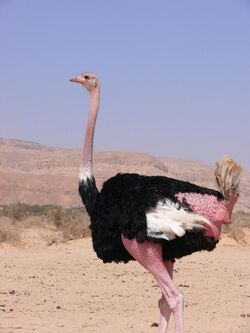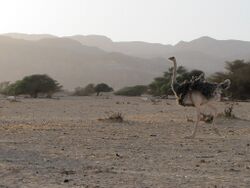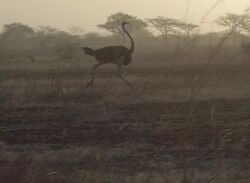North African ostrich
Topic: Biology
 From HandWiki - Reading time: 5 min
From HandWiki - Reading time: 5 min
| North African ostrich[1] | |||
|---|---|---|---|

| |||
| Male | |||

| |||
| Female | |||
| Scientific classification | |||
| Domain: | Eukaryota | ||
| Kingdom: | Animalia | ||
| Phylum: | Chordata | ||
| Class: | Aves | ||
| Infraclass: | Palaeognathae | ||
| Order: | Struthioniformes | ||
| Family: | Struthionidae | ||
| Genus: | Struthio | ||
| Species: | |||
| Subspecies: | S. c. camelus
| ||
| Trinomial name | |||
| Struthio camelus camelus | |||

| |||
Struthio camelus distribution map
| |||
The North African ostrich,[1] red-necked ostrich, or Barbary ostrich (Struthio camelus camelus) is the nominate subspecies of the common ostrich from West and North Africa. It has the largest average size among the subspecies of ostriches, making it the largest living bird.
Evolutionary history
In the 1990s, mtDNA analyses control region haplotypes revealed that the Arabian ostrich from Western Asia is closely related to the North African ostrich.[2]
In 2017, the Birbal Sahni Institute of Palaeobotany discovered that common ostriches used to live in India about 25,000 years ago. DNA research on eleven fossilised eggshells from eight archaeological sites in the states of Rajasthan, Gujarat and Madhya Pradesh found 92% genetic similarity between the eggshells and the North African ostrich.[3][4]
Description
The North African ostrich is the largest subspecies of S. camelus, at 2.74 m (9.0 ft) in height and up to 154 kilograms (340 lb) in weight. The neck is pinkish-red, the plumage of males is black and white, and the plumage of females is gray.[5]
Habitat and distribution
The North African ostrich was widespread from western to northeastern Africa. It used to range from Ethiopia and Sudan in the east throughout the Sahel to Senegal and Mauritania in the west, and north to Egypt and southern Morocco. It has now disappeared from large parts of this range and it only remains in 6 of the 18 countries where it originally occurred.[6] This subspecies may also have occurred in the Sinai Peninsula, where Arabian ostriches once lived. North African ostriches can be found in open fields and the savannahs, especially in the Sahel of Africa.[7] In Israel, the introduced North African ostriches live in grasslands, semi-deserts and plains.[8]
Conservation status
The North African ostrich had dramatically declined to the point where it is now included on CITES Appendix I and some treat it as Critically Endangered.[6] The North African ostrich is part of a project by the Sahara Conservation Fund (SCF) with the aim of saving the subspecies from extinction and restore its populations in its former ranges in the Sahara and the Sahel.[6]
Reintroduction projects
Africa
The North African ostrich was the most widespread subspecies of ostrich. It formerly had an extensive range but is now thought to live in fragmented pockets in Cameroon, Chad, Central African Republic and Senegal, whilst extinct in most of its range in northern Africa. Reintroduction projects for the ostriches have begun, especially in northern Sahara, where North African ostriches had been extinct for 50 years. Ostriches were imported from Chad and reintroduced to Souss-Massa National Park in Morocco.[9]
In Tunisia, North African ostriches were once common in the southern region of the country. The subspecies had been extirpated since 1887. In 2014, North African ostriches were finally returned to Tunisia after 127 years of being extinct. The birds were first reintroduced to Dghoumès National Park. They were then reintroduced to Sidi Toui National Park, and then to Orbata Faunal Reserve.[10][11]
It is planned that the red-necked ostrich will also recover in other countries from western to northeastern Africa, such as Niger and Nigeria.[12]
Asia
The North African ostrich is the closest relative to the extinct Arabian ostrich from Western Asia. Following analyses of mtDNA control region haplotypes that confirmed the close relationship of the Arabian and the North African subspecies, the North African subspecies was considered suitable for introduction into areas where the Arabian subspecies used to live.[2]
In 1988–89, the ostriches, originally taken from Sudan, were introduced to National Wildlife Research Center in Saudi Arabia. A reintroduction project using the North African ostriches was set up at Mahazat as-Sayd Protected Area in 1994. Currently, it is estimated that 90 to 100 individuals are living within the reserve. It was proposed that the North African ostriches should also reintroduced to Al-Khunfah Protected Area.[13]
It also has been reintroduced in the Yotvata Hai-Bar Nature Reserve in Israel as well and some will eventually be released in open fields of the Negev desert.[14] However, the reintroduction failed, as the reintroduced ostriches vanished. The red-necked ostriches were previously found at the Eilat mountains, the Negev desert and the southern Arabah desert. It is thought that the vanished species may have left Israel for Egypt or the Nahal Seifim. The reintroduction project for the ostriches was on hiatus, but the authority might try again in the future. It is hoped that Jordan and Egypt would collaborate with Israel to ensure that the ostriches can live in a broader range.[15]
In captivity
North African ostriches in captivity are mostly breeding populations in European and Middle Eastern zoos, such as Hanover, Hamburg, and Paignton Zoo.
References
- ↑ 1.0 1.1 "Ostrich". Sahara Conservation Fund. http://www.saharaconservation.org/?Ostrich.
- ↑ 2.0 2.1 Freitag, Stephanie; Robinson, Terence J. (1993). "Phylogeographic patterns in mitochondrial DNA of the Ostrich (Struthio camelus)". The Auk 110 (3): 614–622. doi:10.2307/4088425. http://sora.unm.edu/sites/default/files/journals/auk/v110n03/p0614-p0622.pdf.
- ↑ R. Prasad (10 March 2017). "Ostriches lived in India once". The Hindu. http://www.thehindu.com/todays-paper/tp-national/ostriches-lived-in-india-once/article17438046.ece.
- ↑ "Ostriches lived in India 25,000 yrs ago: BSIP study". The Times of India. 10 March 2017. http://timesofindia.indiatimes.com/city/lucknow/ostriches-lived-in-india-25000-yrs-ago-bsip-study/articleshow/57565265.cms.
- ↑ Clive Roots (2006). Flightless Birds. p. 26. ISBN 9780313335457. https://books.google.com/books?id=Sb1IJYzXZhUC&pg=PT45. Retrieved 4 May 2015.
- ↑ 6.0 6.1 6.2 Sahara Conservation Fund: "Ostrich Conservation, Niger". Archived from the original on August 20, 2010. https://web.archive.org/web/20100820040150/http://www.saharaconservation.org/spip.php?page=project&id_article=36.
- ↑ "Severe decline of large birds in the Northern Sahel of West Africa: a long-term assessment". Bird Conservation International. December 2006. http://journals.cambridge.org/action/displayAbstract?fromPage=online&aid=584244&fileId=S0959270906000487.
- ↑ "Ostriches to run wild in Negev". boker.org.il. http://www.boker.org.il/english/ostriches.htm.
- ↑ "Red-necked Ostrich reintroduced to the Sahara after 50 years". Wordpress. http://www.magornitho.org/2013/05/ostrich-reintroduction-sahara/.
- ↑ "The return of the long lost North-African ostrich to Tunisia". Marwell Wildlife. https://www.marwell.org.uk/conservation/news/6/the-return-of-the-long-lost-north-african-ostrich-to-tunisia.
- ↑ Tim Woodfine, Marie Petretto; Tanya Langenhorst (April 2015). Reintroduction and conservation of North African / red-necked ostrich, Struthio camelus camelus, to protected areas in southern Tunisia. Marwell Wildlife. https://www.marwell.org.uk/cms-assets/documents/225595-796261.ostrich-report-and-proposal-2015.pdf. Retrieved 4 January 2016.
- ↑ "NORTH AFRICAN OSTRICH RECOVERY IN NIGER". Woodland Park Zoo. http://www.zoo.org/conservation/ostrichrecovery#.VopIblLXFn5.
- ↑ M. Zafar-ul Islam; Ahmed Boug; Mohammed Shobrak (2008). "Conservation Status of reintroduced red-necked ostrich in Mahazat as-Sayd, Saudi Arabia". in Pritpal S. Soorae. Global Re-introduction Perspectives: Re-introduction Case-studies from Around the Globe. IUCN/SSC Re-introduction Specialist Group. ISBN 978-2831711133.
- ↑ Robinson, Terence J.; Matthee, Conrad A. (1999). "Molecular genetic relationships of the extinct ostrich, Struthio camelus syriacus: consequences for ostrich introductions into Saudi Arabia". Animal Conservation 2 (3): 165–171. doi:10.1111/j.1469-1795.1999.tb00062.x.
- ↑ Zafrir Rinat (25 December 2007). "The Bitter Fate of Ostriches in the Wild". Haaretz. https://www.haaretz.com/2007-12-25/ty-article/the-bitter-fate-of-ostriches-in-the-wild/0000017f-db5a-db5a-a57f-db7af66d0000.
Wikidata ☰ Q3976170 entry
 |
 KSF
KSF

